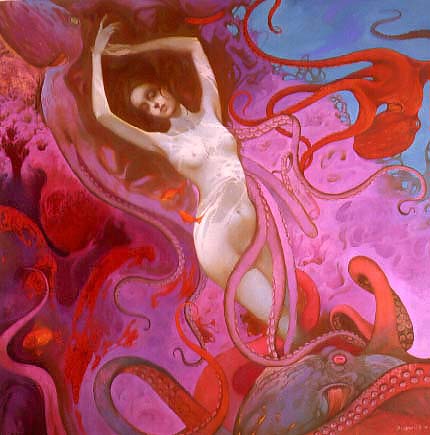"Some are born knowing who they are and where they are going. Others spend their entire lives trying to find out. Some never do. Svetlana Valueva has always known.
Born in Moscow on the 24th of October, 1966, Ms. Valueva remembers drawing and painting as a toddler. While many of us look back fondly on the loftier days of crayons and finger painting, Ms. Valueva had been painting seriously at 18 months of age. Her mother recently found a painting of a bird, a dog-like animal, and a queen confirming her age as 18 months.
Ms. Valueva’s father, an artist, recognized her talent and became her first and most important teacher, encouraging her to paint alongside him in his studio. At five, Ms. Valueva began writing poems and stories expressing the feelings of the characters she drew. This treasured childhood art is part of her parents' "private collection".
Thirteen years of state structured curriculum taught by both the academic school and institute established Ms. Valueva's art and drawing skills in "social realism". Like many children of the arts, Ms. Valueva was accepted at art school at age six. She began her formal training and two years later took part in local, countrywide and international juried exhibitions. At the age of eight she entered a Cuban International exhibition, receiving a gold medal and 10 lbs. of Cuban sugar as her prize.
In 1975 at nine, she received the Gran Prix at the annual International exhibition in Delhi, India. This juried exhibition of children's paintings, established in 1952, grew to 150,000 children from 35 countries exhibiting work in 1975. In 1977 Svetlana received 3rd place, and again in 1979 she won the gold (Gran Prix) at this prestigious event.
1977 was a memorable year for Ms. Valueva as a documentary about outstanding achievers in art, featuring her, was shown in movie theaters across Russia. The same year she was highlighted on the front page of a popular monthly magazine "Soviet Union". Few people achieve such an honor much less at the age of 11.
In the Seventies, the only style permitted for Soviet artists remained Socialist Realism. The first time Ms. Valueva opened art books, which were given to her secretly by a friend, she was astonished by the images of Klimt, Alfons Mucha, Sargent, and Alma-Tadema. This was one of the most important realizations of her life as she recognized that her passion lay with those artists, and not with the "acceptable" realism.
Ms. Valueva immediately began painting a required set of art for school, and allowed her true style to emerge in works painted at home. Her father had given her his studio, and she lived and worked there. Soon, a steady stream of people interested in new emerging talent rather than "official" art flocked to visit the studio. Before graduation she began to sell her "hidden" work to dealers from Belgium, France and Poland. She became so popular that the Academy faculty had no choice but to award her a summer's trip to study in Europe.
Ms. Valueva had her first solo show in a prestigious Moscow gallery in 1993. Influenced by photographs left by her great grandmother, a ballerina at the Mariinsky (Kirov) Ballet Theater, and by her great grandfather, an officer in the Czar's army, the twelve paintings generated immediate interest. A Japanese publisher approached her concerning the production of the collection, purchasing all the exhibited paintings and requesting more.
1995 brought a commission by The Bolshoi Theater for a ballet collection. Invited to rehearsals by the art director of the company, her resultant fifteen-painting series is on permanent display in the Bolshoi foyer, and was used for two years as the opening backdrop for a weekly TV ballet program called "Entrance 15".
Nostalgia for the elevated, magnificent "silver age" of Russia has drawn her to the past, a period known in the West as Art Nouveau, Jugendstil, or Liberty. This is where the characters of Ms. Valueva's paintings are destined to dwell.
"It's hard today to trace back the origins of my affinity for Art Nouveau, a style which emerged on the brink of the 20th century. I feel I was destined to love this art from birth. This elaborate, refined, truly aristocratic style, regardless of subject matter, conversely captures the fragility of all earthbound existence. Decadence became second nature to me, its' reflection in my works, again being created at the crossroads of centuries".
In her paintings, women often live in a mystical world, surrounded by bizarre forms, signs and objects - a world real to them, to be taken seriously. "Mirror of Art Nouveau", her first collection, was twelve works about love, life and beauty, "My female friends; an actress, a fashion designer and a photographic artist, were the prototypes for my characters", says Ms. Valueva. Designing costumes for these models, she drew numerous preliminary sketches. After six months, her subjects appeared unlike themselves, having lost the aura of earthly problems. Svetlana Valueva peers into an inner spiritual world and expresses that on canvas.
"Why are my subjects women. Because beauty excites me, I like to see transformations, diversity, the layers covering the vulnerable paleness of a female arm, or tender mat luster of flesh; the skin's translucence beneath a film of gauze draping a naked body. It might as well be the ultramarine of the night sky and the whiteness of the stars. It would be the emerald of riverweeds in a Japanese garden on a foggy morning... Tiny drops of dew on the sedge. My brush does not just move about the surface, it carefully penetrates the space of another dimension, going beyond the frontier - which is insurmountable to anyone else. There truly is space and life behind that fragile margin, as in a mirror. Of these space and life forms I express my daily chronicles, of their everyday life and feasts. And - of women who belong there".





ليست هناك تعليقات:
إرسال تعليق